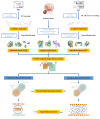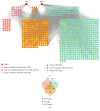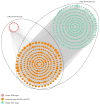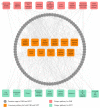Systems Pharmacology-Based Approach to Comparatively Study the Independent and Synergistic Mechanisms of Danhong Injection and Naoxintong Capsule in Ischemic Stroke Treatment
- PMID: 30863452
- PMCID: PMC6378776
- DOI: 10.1155/2019/1056708
Systems Pharmacology-Based Approach to Comparatively Study the Independent and Synergistic Mechanisms of Danhong Injection and Naoxintong Capsule in Ischemic Stroke Treatment
Abstract
To provide evidence for the better clinical use of traditional Chinese medicine preparations (TCMPs), comparison of the pharmacological mechanisms between TCMPs with similar therapeutic effect is necessary. However, methodology for dealing with this issue is still scarce. Danhong injection (DHI) and Naoxintong capsule (NXT) are representative TCMPs for ischemic stroke (IS) treatment, which are also frequently used in combination. Here they were employed as research objects to demonstrate the feasibility of systems pharmacology approach in elucidation of the independent and combined effect of TCMPs. By incorporating chemical screening, target prediction, and network construction, a feasible systems pharmacology model has been established to systematically uncover the underlying action mechanisms of DHI, NXT, or their pair in IS treatment. Systematic analysis of the created TCMP-Compound-Target-Disease network revealed that DHI and NXT shared common targets such as PTGS2, F2, ADRB1, IL6, ALDH2, and CCL2, which were involved in the vasomotor system regulation, blood-brain barrier disruption, redox imbalance, neurotrophin activity, and brain inflammation. In comparative mechanism study, the merged DHI/NXT-IS PPI network and pathway enrichment analysis indicated that DHI and NXT exerted the therapeutic effects mainly through immune system and VEGF signaling pathways. Meanwhile, they had their own unique pathways, e.g., calcium signaling pathway for DHI and gap junction for NXT. While for their synergistic mechanism, DHI and NXT participated in chemokine signaling pathway, T cell receptor signaling pathway, VEGF signaling pathway, gap junction, and so on. Our study provided an optimized strategy for dissecting the different and combined effect of TCMPs with similar actions.
Figures






Similar articles
-
Protective effect of Danhong Injection combined with Naoxintong Capsule on cerebral ischemia-reperfusion injury in rats.J Ethnopharmacol. 2018 Jan 30;211:348-357. doi: 10.1016/j.jep.2017.10.002. Epub 2017 Oct 3. J Ethnopharmacol. 2018. PMID: 28986333
-
Network pharmacology exploration reveals endothelial inflammation as a common mechanism for stroke and coronary artery disease treatment of Danhong injection.Sci Rep. 2017 Nov 13;7(1):15427. doi: 10.1038/s41598-017-14692-3. Sci Rep. 2017. PMID: 29133791 Free PMC article.
-
Pharmacological Mechanisms Underlying the Therapeutic Effects of Danhong Injection on Cerebral Ischemia.Evid Based Complement Alternat Med. 2021 May 21;2021:5584809. doi: 10.1155/2021/5584809. eCollection 2021. Evid Based Complement Alternat Med. 2021. PMID: 34093718 Free PMC article.
-
The cardioprotective properties and the involved mechanisms of NaoXinTong Capsule.Pharmacol Res. 2019 Mar;141:409-417. doi: 10.1016/j.phrs.2019.01.024. Epub 2019 Jan 17. Pharmacol Res. 2019. PMID: 30660824 Review.
-
Naoxintong capsule for treating cardiovascular and cerebrovascular diseases: from bench to bedside.Front Pharmacol. 2024 Jun 27;15:1402763. doi: 10.3389/fphar.2024.1402763. eCollection 2024. Front Pharmacol. 2024. PMID: 38994201 Free PMC article. Review.
Cited by
-
Investigation of Invigorating Qi and Activating Blood Circulation Prescriptions in Treating Qi Deficiency and Blood Stasis Syndrome of Ischemic Stroke Patients: Study Protocol for a Randomized Controlled Trial.Front Pharmacol. 2020 Jun 17;11:892. doi: 10.3389/fphar.2020.00892. eCollection 2020. Front Pharmacol. 2020. PMID: 32625091 Free PMC article.
-
A study of the therapeutic mechanism of Jakyakgamcho-Tang about functional dyspepsia through network pharmacology research.Int J Med Sci. 2022 Oct 17;19(13):1824-1834. doi: 10.7150/ijms.77451. eCollection 2022. Int J Med Sci. 2022. PMID: 36438925 Free PMC article.
-
Comparison of the Efficacy of Danhong Injections at Different Time-points During the Perioperative Period of Acute Myocardial Infarction: A Systematic Review and Meta-analysis of Randomized Controlled Trials.Front Pharmacol. 2021 Apr 29;12:643446. doi: 10.3389/fphar.2021.643446. eCollection 2021. Front Pharmacol. 2021. PMID: 33995051 Free PMC article. Review.
-
Network Pharmacology and Molecular Docking Analysis on Molecular Targets and Mechanisms of Buyang Huanwu Decoction in the Treatment of Ischemic Stroke.Evid Based Complement Alternat Med. 2021 Feb 26;2021:8815447. doi: 10.1155/2021/8815447. eCollection 2021. Evid Based Complement Alternat Med. 2021. PMID: 33727944 Free PMC article.
-
Investigation of Anti-Liver Cancer Activity of the Herbal Drug FDY003 Using Network Pharmacology.Evid Based Complement Alternat Med. 2022 Sep 9;2022:5765233. doi: 10.1155/2022/5765233. eCollection 2022. Evid Based Complement Alternat Med. 2022. PMID: 36118098 Free PMC article.
References
-
- Benjamin E. J., Virani S. S., Callaway C. W., et al. Heart disease and stroke statistics2018 update: a report from the American Heart Association. Circulation. 2018;137(12):e67–e492. - PubMed
-
- Asadi H., Williams D., Thornton J. Changing management of acute ischaemic stroke: The new treatments and emerging role of endovascular therapy. Current Treatment Options in Neurology. 2016;18(5) - PubMed
LinkOut - more resources
Full Text Sources
Research Materials
Miscellaneous

